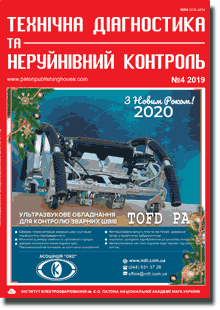Access for download PDF files for subscribers and for reviewers of scientometric bases.
Organization: Elsevier for content access(PDF files of journals released before 2024 are available for download from the website's archives))
Organization: Elsevier for content access(PDF files of journals released before 2024 are available for download from the website's archives))
| 2019 №04 (02) |
DOI of Article 10.15407/tdnk2019.04.03 |
2019 №04 (04) |

"Tekhnichna Diahnostyka ta Neruinivnyi Kontrol" (Technical Diagnostics and Non-Destructive Testing) #4, 2019, pp. 31-39
Determination of fiberglass damage by the method of AE scanning
S.A. Nedoseka1, A.Ya. Nedoseka1, M.A. Shevtsova2
1E.O. Paton Electric Welding Institute of the NAS of Ukraine. 11 Kazymyr Malevych Str., 03150, Kyiv. E-mail: office@paton.kiev.ua
2N.E. Zhukovsky National Aerospace University «Kharkiv Aviation Institute». 17 Chkalov Str., 61070, Kharkiv, Ukraine.
Fiberglasses belong to composite materials, including those ever wider used in the most diverse engineering fields. Their application requires development of the most reliable methods of nondestructive testing for structure state assessment, both in service and directly after fabrication. The second is not less important, as it allows rejecting materials with defects, even before they are used for manufacturing structural elements. This work provides an assessment of applicability of the method of acoustic-emission (AE) scanning on the base of EMA type equipment for samples of fiberglass made by the method of manual laying of glass fabric Aeroglass 280 and binder Elan-tech ECW157 + Elan-tech W152XLR. Checking of the location of AE source coordinates on unloaded samples was performed. It is shown that the studied material is controllable by AE method, and allows determination of AE source coordinates with sufficient accuracy at test sounding. Numerous experiments on scanning the samples in the longitudinal direction have been performed, when each of AE transducers alternatively acted as test signal emitter. From six tested samples three contained an element built-in in the center, which simulated an acoustic piezo transducer. Testing showed that using AE scanning allows differentiating between the acoustics properties of the samples without loading them, in the presence and absence of such a built-in concentrator, and quantitatively assessing the damage of the material with the concentrator. The importance of obtained results for development of a procedure for control of composites with application of AE scanning technology and providing precise criteria of damage assessment is noted. 7 Ref., 10 Fig.
Keywords: composites, fiberglass, nondestructive methods, damage, acoustic emission scanning.
Received: 29.05.2019
Published: 11.12.2019
References
1. Nedoseka, S.A., Nedoseka, A.Ya., Shevtsova, M.A. et al. (2018) Acoustic emission at composite material testing. Tekh. Diagnost. i Nerazrush. Kontrol, 4, 36-40 [in Russian]. https://doi.org/10.15407/tdnk2018.04.042. Lebedev, A.A. et al. (1995) Model of damage accumulation in metallic materials under static tension. Problemy Prochnosti, 7, 31-40 [in Russian]. https://doi.org/10.1007/BF02209362
3. Lebedev, A.A., Nedoseka, A.Ya., Chausov, N.G., Nedoseka, S.A. (2001) Evaluation of the degree of damage of the active gas pipeline metal by the scanning method. Tekh. Diagnost. i Nerazrush. Kontrol, 1, 8-12 [in Russian].
4. Chausov, N.G., Nedoseka, S.A.,Pilipenko, A.P. (2004) Integrated evaluation of damage of ductile materials under different loading modes. Ibid., 3, 16-21 [in Russian].
5. Nedoseka, S.A., Nedoseka, A.Ya. (2010) Integrated assessment of damage level and residual life of metals with certain operating life. Ibid., 1, 9-16 [in Russian].
6. Paton B.E. et al. (2012) Acoustic emission and service life of structures: Album. Kiev, Indprom.
7. Nedoseka, A.Ya., Nedoseka, S.A., Yaremenko, M.A. et al. (2013) Software of AE diagnostic systems EMA-3.9. Tekh. Diagnost. i Nerazrush. Kontrol, 3, 16-22 [in Russian].
The cost of subscription/purchase order journals or individual articles
| Journal/Currency | Annual Set | 1 issue printed |
1 issue |
one article |
| TPWJ/USD | 384 $ | 32 $ | 26 $ | 13 $ |
| TPWJ/EUR | 348 € | 29 € | 24 € | 12 € |
| TPWJ/UAH | 7200 UAH | 600 UAH | 600 UAH | 280 UAH |
| AS/UAH | 1800 UAH | 300 UAH | 300 UAH | 150 UAH |
| AS/USD | 192 $ | 32 $ | 26 $ | 13 $ |
| AS/EUR | 180 € | 30 € | 25 € | 12 € |
| SEM/UAH | 1200 UAH | 300 UAH | 300 UAH | 150 UAH |
| SEM/USD | 128 $ | 32 $ | 26 $ | 13 $ |
| SEM/EUR | 120 € | 30 € | 25 € | 12 € |
| TDNK/UAH | 1200 UAH | 300 UAH | 300 UAH | 150 UAH |
| TDNK/USD | 128 $ | 32 $ | 26 $ | 13 $ |
| TDNK/EUR | 120 € | 30 € | 25 € | 15 € |
AS = «Automatic Welding» - 6 issues per year;
TPWJ = «PATON WELDING JOURNAL» - 12 issues per year;
SEM = «Electrometallurgy Today» - 4 issues per year;
TDNK = «Technical Diagnostics and Non-Destructive Testing» - 4 issues per year.





